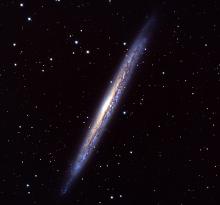Listen to today's episode of StarDate on the web the same day it airs in high-quality streaming audio without any extra ads or announcements. Choose a $8 one-month pass, or listen every day for a year for just $30.
You are here
Cat’s Eye Nebula
The Cat’s Eye Nebula isn’t just nice to look at, it’s nice to listen to as well. Scientists have converted images of the nebula to sound, providing a new way to appreciate its beauty.
The nebula is the final gasp of a dying star. The nuclear reactions in the star’s core are shutting down, so it’s pumping its outer layers of gas out into space. That’s formed a complicated series of bubbles and shells. The central bubbles are bright and colorful, and resemble the eye of a cat.
It’s surrounded by more bubbles, nested one inside the other. They may have formed at intervals of about 1500 years, as the star blew them into space. If so, then the first one began forming about 15,000 years ago as seen from Earth. The bright central bubbles began forming just one thousand years ago, and signal the star’s demise. Eventually, only its hot but dead core will remain: a white dwarf.
Astronomers converted images of the nebula to sound. The sounds represent different wavelengths, and the intensity of the different parts of the image. They scan from the center of the nebula like a radar beam — providing a new way to appreciate this beautiful dying star.
The Cat’s Eye Nebula is in Draco, the dragon, which coils around Polaris, the North Star. The nebula is off to the upper right of Polaris at nightfall, and is a popular target for small telescopes.
Script by Damond Benningfield



